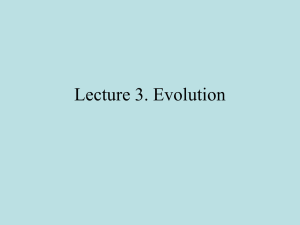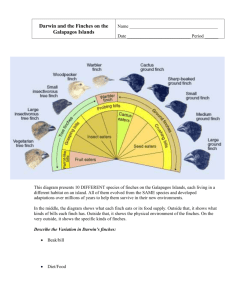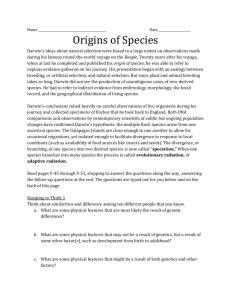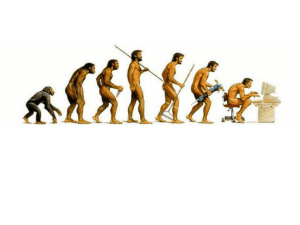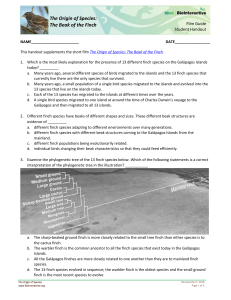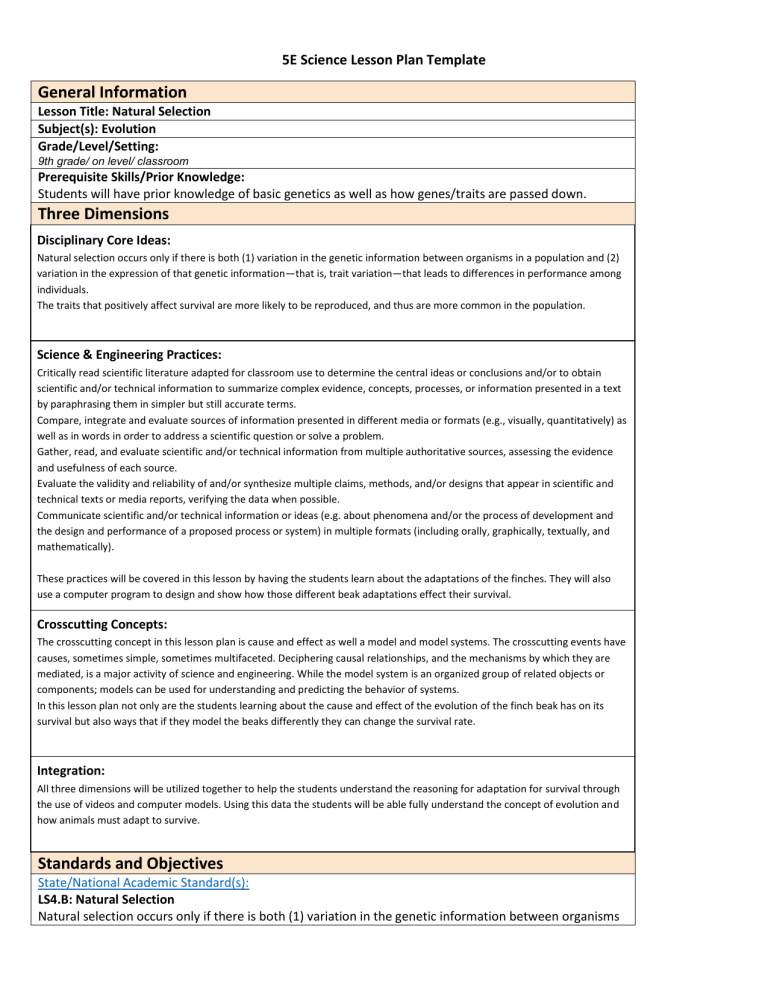
5E Science Lesson Plan Template General Information Lesson Title: Natural Selection Subject(s): Evolution Grade/Level/Setting: 9th grade/ on level/ classroom Prerequisite Skills/Prior Knowledge: Students will have prior knowledge of basic genetics as well as how genes/traits are passed down. Three Dimensions Disciplinary Core Ideas: Natural selection occurs only if there is both (1) variation in the genetic information between organisms in a population and (2) variation in the expression of that genetic information—that is, trait variation—that leads to differences in performance among individuals. The traits that positively affect survival are more likely to be reproduced, and thus are more common in the population. Science & Engineering Practices: Critically read scientific literature adapted for classroom use to determine the central ideas or conclusions and/or to obtain scientific and/or technical information to summarize complex evidence, concepts, processes, or information presented in a text by paraphrasing them in simpler but still accurate terms. Compare, integrate and evaluate sources of information presented in different media or formats (e.g., visually, quantitatively) as well as in words in order to address a scientific question or solve a problem. Gather, read, and evaluate scientific and/or technical information from multiple authoritative sources, assessing the evidence and usefulness of each source. Evaluate the validity and reliability of and/or synthesize multiple claims, methods, and/or designs that appear in scientific and technical texts or media reports, verifying the data when possible. Communicate scientific and/or technical information or ideas (e.g. about phenomena and/or the process of development and the design and performance of a proposed process or system) in multiple formats (including orally, graphically, textually, and mathematically). These practices will be covered in this lesson by having the students learn about the adaptations of the finches. They will also use a computer program to design and show how those different beak adaptations effect their survival. Crosscutting Concepts: The crosscutting concept in this lesson plan is cause and effect as well a model and model systems. The crosscutting events have causes, sometimes simple, sometimes multifaceted. Deciphering causal relationships, and the mechanisms by which they are mediated, is a major activity of science and engineering. While the model system is an organized group of related objects or components; models can be used for understanding and predicting the behavior of systems. In this lesson plan not only are the students learning about the cause and effect of the evolution of the finch beak has on its survival but also ways that if they model the beaks differently they can change the survival rate. Integration: All three dimensions will be utilized together to help the students understand the reasoning for adaptation for survival through the use of videos and computer models. Using this data the students will be able fully understand the concept of evolution and how animals must adapt to survive. Standards and Objectives State/National Academic Standard(s): LS4.B: Natural Selection Natural selection occurs only if there is both (1) variation in the genetic information between organisms in a population and (2) variation in the expression of that genetic information — that is, trait variation — that leads to differences in performance among individuals. LS4.C: Adaptation Evolution is a consequence of the interaction of four factors: (1) the potential for a species to increase in number, (2) the genetic variation of individuals in a species due to mutation and sexual reproduction, (3) competition for an environment’s limited supply of the resources that individuals need in order to survive and reproduce, and (4) the ensuing proliferation of those organisms that are better able to survive and reproduce in that environment. Learning Objective(s): Identify what students will accomplish by the end of the lesson; needs to align with the state or Common Core State Standards and needs to be measurable (condition, behavior, and criterion). Upon completion of this lesson, students will be able to: Write a paper using a real example to illustrate the process of natural selection. Make sure that you can justify how at least 3 of the 4 factors contribute to natural selection apply to the scenario. Will demonstrate their understanding of adaptations and natural selection by answering 4 out of the 5 post activity questions. At the end of this lesson students will take a quiz over this lesson, working alone and using only their personal notes, and will score at least 5 of 8 points possible on Darwin’s finches and evolution. Materials Technology What materials will the teacher and the students need in order to complete the lesson? Computers with internet access Small poster boards Art supplies for drawing and coloring Will use internet to help the students research more about evolution with the pHET simulation app. These can be done on chromebooks or ipads. This will also allow them to use Google Docs to share information that they find with their group members. Safety Concerns There are no safety concerns for this lesson. It will be performed in a classroom setting. Language Demands Language Function: The students must be able to relay their findings about the evolution of the finch beak to their classmates. Vocabulary: Adaptation, evolution, species, fossil, fossil record, natural selection, trait, selective breeding, speciation, generation time, population, sediments, mammals and naturalist. Discourse and/or Syntax: Students will use scientific discourse throughout the presentations of their assigned scientific concepts. Planned Language Supports: The teacher will provide copies of unit notes. The teacher will model, discuss, and identify the elements of a presentation of the activity. 5E Instructional Strategies and Learning Tasks Activity Description/Teacher Engagement: a) We are going to begin today’s class by watching a video on Darwin on Natural Selection b) Share out answer, find pattern, and go over answers Exploration: pHET simulation with Bunnies a) Give students five minutes to explore the simulation. #1 b) Students fill in observation table #2 c) Students work through the 3 challenges to accomplish goals. d) Share out answers at end! Explanation: a) Natural Selection Vocabulary. b) Students fill in what they know. Share out. Ask questions about holes. c) Then do 4 examples of natural selection. Elaboration: Darwin Finch Lab a) Show PPT files with all different birds b) Students fill out what do they eat c) Students go over instructions for Darwin Finch Beak Lab d) Students perform lab and answer analysis questions on the chrome books Evaluation: a) Assessment: Show what you know. Differentiated Instruction Student Actions a) Watch video on Darwin and Natural Selection a) Virtual Lab on Lizard Evolution http://www.hhmi.org/biointeractive/lizardevolution-virtual-lab b) Laptops a) Natural Selection Vocab WS a) Darwin Finch PPT b) Darwin Finch Lab c) Different beaks, rice, and beans a) Assessment: Show what you know. Consider how to accommodate for the needs of each type of student. Be sure that you provide content specific accommodations that help to meet a variety of learning needs. Gifted and Talented: These students will be grouped together so that they may continue on to additional content if they finish the lesson early. They will be provided with additional material to further their knowledge of evolution beyond the common lesson plan. These students will excel at the given tasks and be provided the opportunity to go to the Natural Wildlife Museum to view the specimens on display to see how evolution has played a part in survival of today's animals. English Language Learner (ELL): Textbook resources in alternate languages can be used to support ELLs, and poster assignment might be done in primary language. Students with Other Special Needs: Additional time and scaffolding should be provided as needed based on preparation and ability. Working with larger collaborative groups can also be used. Assessment Formative: Engage: After designing their finches and seeing the result of the hunt for seeds, students should be able to explain that finches were able to find seeds easier based on their beaks, and were therefore less likely to survive. Explore: While exploring the web lab, students will complete a lab sheet with comprehension check questions. Instructor will check for understanding throughout activity. Explain: Students' groups will produce a poster, which will be evaluated according to a rubric. Students will evaluate posters and select the best to be posted in the room. Posters should illustrate each factor (variation, competition, overproduction, and environmental change) with a realistic example. Summative: Students will complete the following essay question either as part of their unit exam or as a research extension to their lab report: Use a real example to illustrate the process of natural selection. Make sure that you can justify how at least 3 of the 4 factors that contribute to natural selection apply to the scenario. Do not use one we have already discussed in class, and make sure that your example is based on research, not made up to suit the scenario.

